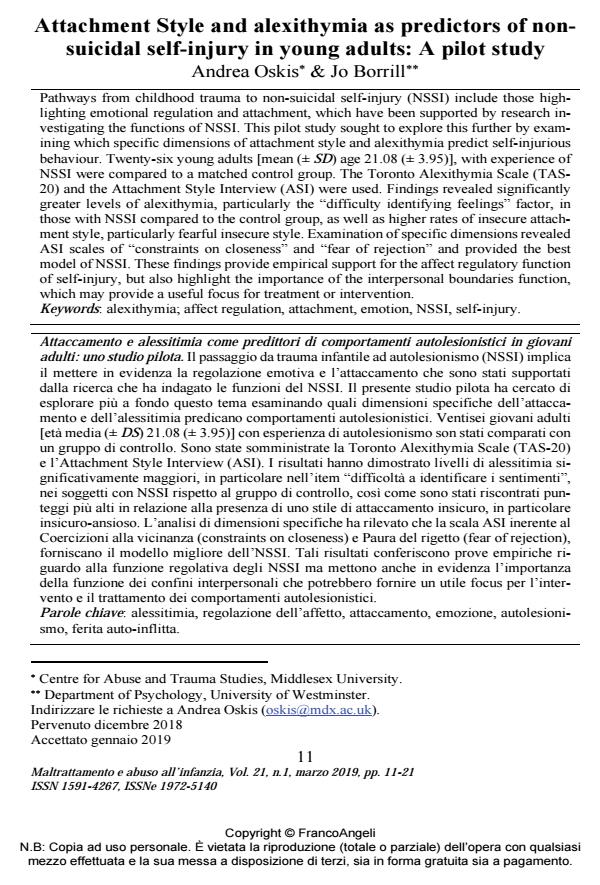Attachment Style and alexithymia as predictors of nonsuicidal self-injury in young adults: A pilot study
Journal title MALTRATTAMENTO E ABUSO ALL’INFANZIA
Author/s Andrea Oskis, Jo Borrill
Publishing Year 2019 Issue 2019/1
Language English Pages 11 P. 11-21 File size 382 KB
DOI 10.3280/MAL2019-001002
DOI is like a bar code for intellectual property: to have more infomation
click here
Below, you can see the article first page
If you want to buy this article in PDF format, you can do it, following the instructions to buy download credits

FrancoAngeli is member of Publishers International Linking Association, Inc (PILA), a not-for-profit association which run the CrossRef service enabling links to and from online scholarly content.
Pathways from childhood trauma to non-suicidal self-injury (NSSI) include those high-lighting emotional regulation and attachment, which have been supported by research inves-tigating the functions of NSSI. This pilot study sought to explore this further by examining which specific dimensions of attachment style and alexithymia predict self-injurious behav-iour. Twenty-six young adults [mean (± SD) age 21.08 (± 3.95)], with experience of NSSI were compared to a matched control group. The Toronto Alexithymia Scale (TAS-20) and the Attachment Style Interview (ASI) were used. Findings revealed significantly greater levels of alexithymia, particularly the "difficulty identifying feelings" factor, in those with NSSI compared to the control group, as well as higher rates of insecure attachment style, particularly fearful insecure style. Examination of specific dimensions revealed ASI scales of "constraints on closeness" and "fear of rejection" and provided the best model of NSSI. These findings provide empirical support for the affect regulatory function of self-injury, but also highlight the importance of the interpersonal boundaries function, which may pro-vide a useful focus for treatment or intervention.
Keywords: Alexithymia; affect regulation, attachment, emotion, NSSI, self-injury.
- The relationship between self‐harm and alexithymia: A systematic review and meta‐analysis Hilary Norman, Andrea Oskis, Lisa Marzano, Mark Coulson, in Scandinavian Journal of Psychology /2020 pp.855
DOI: 10.1111/sjop.12668
Andrea Oskis, Jo Borrill, Attachment Style and alexithymia as predictors of nonsuicidal self-injury in young adults: A pilot study in "MALTRATTAMENTO E ABUSO ALL’INFANZIA" 1/2019, pp 11-21, DOI: 10.3280/MAL2019-001002